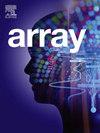Forecasting loan, deferred rate and customer segmentation in banking industry: A computational intelligence approach
IF 4.5
Q2 COMPUTER SCIENCE, THEORY & METHODS
引用次数: 0
Abstract
Accurate loan default prediction and customer segmentation are critical challenges in the banking industry. This study proposes a novel hybrid model integrating Multi-Layer Perceptron (MLP) neural networks with Self-Adaptive Particle Swarm Optimization (PSO) and Genetic Algorithm (GA) frameworks. GA handles feature selection, while PSO optimizes MLP hyperparameters (e.g., learning rate, neurons, activation functions). The model dynamically enhances classification accuracy and resilience, particularly for imbalanced datasets in loan default prediction. Using real-world data from Sina Bank, the system outperforms Logistic Regression, Decision Trees, and Random Forests. The GA-PSO optimization process, which integrates both PSO and GA to optimize the MLP model's parameters, plays a crucial role in enhancing the accuracy and scalability of the system. Specifically, the GA-PSO-MLP model achieves a 15 % higher classification accuracy than Logistic Regression, a 12 % improvement over Decision Trees, and an 8 % gain over Random Forests. Additionally, false positive rates are reduced by 20 %, and mean squared error (MSE) is lowered by 18 %. The F1-score of the proposed model is 92.3 %, compared to 79.8 % (Logistic Regression), 81.5 % (Decision Trees), and 85.2 % (Random Forests), further highlighting its advantage in handling imbalanced datasets. Extensive numerical validation and sensitivity analysis further highlight the model's effectiveness in delivering actionable insights that enhance customer management strategies and mitigate financial risks. This research makes a substantial contribution to the application of machine learning in banking, facilitating more accurate data-driven decision-making and more robust risk management practices.

银行业贷款预测、递延利率和客户细分:一种计算智能方法
准确的贷款违约预测和客户细分是银行业面临的关键挑战。本文提出了一种将多层感知器(MLP)神经网络与自适应粒子群优化(PSO)和遗传算法(GA)框架相结合的新型混合模型。GA处理特征选择,而PSO优化MLP超参数(例如,学习率,神经元,激活函数)。该模型动态地提高了分类的准确性和弹性,特别是对贷款违约预测中的不平衡数据集。使用来自新浪银行的真实数据,该系统优于逻辑回归、决策树和随机森林。结合粒子群算法和遗传算法对MLP模型参数进行优化的GA-PSO优化过程对提高系统的精度和可扩展性具有重要作用。具体来说,GA-PSO-MLP模型的分类准确率比Logistic回归高15%,比决策树高12%,比随机森林高8%。此外,假阳性率降低了20%,均方误差(MSE)降低了18%。与79.8%(逻辑回归)、81.5%(决策树)和85.2%(随机森林)相比,该模型的f1得分为92.3%,进一步突出了其在处理不平衡数据集方面的优势。广泛的数值验证和敏感性分析进一步强调了该模型在提供可操作的见解方面的有效性,这些见解可以增强客户管理策略并降低财务风险。这项研究为机器学习在银行业的应用做出了重大贡献,促进了更准确的数据驱动决策和更稳健的风险管理实践。
本文章由计算机程序翻译,如有差异,请以英文原文为准。
求助全文
约1分钟内获得全文
求助全文

 求助内容:
求助内容: 应助结果提醒方式:
应助结果提醒方式:


